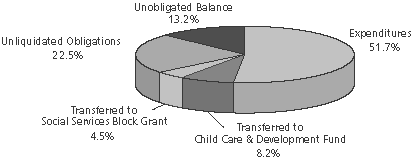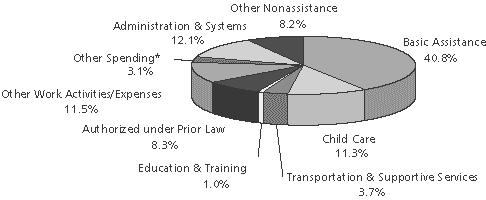Trade, Tariffs, and Soybeans
Trump has consistently claimed that exporters, those countries who are “ripping us off,” are paying the tariffs. However, the actual data tell a different story.
Not only have states diminished their support for cash assistance, but other resources for poor people are drying up too.
The destruction of "welfare as we knew it" dramatically transformed how the U.S. government assists poor families. Under the old entitlement program, Aid to Families with Dependent Children (AFDC), the federal government matched a percentage of state welfare spending, which fluctuated according to the number of families in need. Under the new system, Temporary Assistance for Needy Families (TANF), which Congress approved in 1996, the states receive annual block grants pegged to the amount of federal money they received under AFDC—and not adjusted for inflation. (To qualify for their block grants, the states have to spend some of their own money—but less than what they spent in the final days of AFDC.)
The new system has raised some important questions. First, because so many families have been kicked out of the welfare program under TANF, states have spent much less on basic assistance to poor families than they have received in the form of block grants. How are they using the leftover funds? Second, since caseloads have risen due to the recession, the block grants may be inadequate to meet growing demand. How will states ensure that they have enough resources on hand?
In a report issued last August, the U.S. General Accounting Office (GAO) examined how ten states were allocating their TANF resources and whether they were setting funds aside for a "rainy day." At the same time, the Center for Law and Social Policy (CLASP) released an evaluation of how all states reported using their TANF money in fiscal year 2000 (FY2000).
Here's how the picture looked at the start of FY2000. The states had a total of $24.2 billion in federal TANF funds to work with—$17 billion in current funding, and $7.2 billion carried forward from previous years. By the end of FY2000, the states had spent a total of $12.5 billion—slightly over half of the available funds. (See Chart #1.)
(Total Funds Available = $24,162,964,924).
Source: Center for Law and Social Policy

How did the states spend their federal TANF money? Based on CLASP's findings, it seems like about 41% went for basic assistance, and another 11.3% toward child care. Less than 4% of total spending was reserved for transportation and supportive services, and education and training accounted for a paltry 1%. (See Chart #2.) These figures may not be accurate, though, because states can fiddle around with prior-year funding in their current spending reports.
(Total Expenditures = $12,483,172,895).
Source: Center for Law and Social Policy.

Some spending categories are not clearly defined. For example, 8.3% of spending went for activities authorized under prior law—activities that may not be TANF-related but were approved under earlier programs like AFDC—and states don't have to give details about how they spent those funds. (According to the California Budget Project, some of California's "prior law" money was used for juvenile probation camps.) The states spent another 8.2% on other nonassistance, a miscellaneous catch-all for TANF-related activities that neither qualified as actual "assistance" nor seemed to fit elsewhere. (See Chart #2.)
To understand how states really spent the money, we have to know what's happening on the ground. For example, nine of the ten states in the GAO study were using federal TANF dollars to pay for state programs formerly financed with state funds—and then using the freed-up state funds for other purposes. The state of Texas used at least $320 million in federal TANF money to replace state spending, most notably for child protective services and foster care. While advocates for poor families consider such programs vitally important, they think the state should commit its own resources, not federal welfare funds.
Texas officials claim that they're now spending more money across the board on social services, but Eva De Luna Castro, a budget analyst with the Austin-based Center for Public Policy Priorities (CPPP), disagrees. "The state general revenue is about the same," she says, "and in some cases it actually went down." Spending per client, she adds, has "gone down dramatically." At the same time, she says, the state funds freed up by federal TANF spending helped to pay for $2.3 billion in tax cuts to homeowners and businesses over five years.
There is other dubious spending that the official data don't reveal. In Wisconsin, for example, welfare contractors (counties and private agencies) can keep profits from unspent funds. Contractors have also misused welfare money. One agency, Maximus, agreed to return $1 million as compensation for spending abuses (although the state didn't require the company to pay back $6 million that went to corporate expenses in 1997-99). Another agency, Employment Solutions (a division of Goodwill Industries), was forced to reimburse the state for nearly $500,000 in misspent funds. Employment Solutions also paid out $1.7 million in bonuses to its executives and staff. In the glare of negative publicity, it is now quitting the welfare business, and Wisconsin will spend $3.8 million in—what else?—TANF funds to transfer Employment Solutions cases to other private contractors.
What about the federal TANF funds—nearly half of the total available for FY2000—that weren't spent at all? The states transferred $3 billion, or nearly 13% of what was on hand, to two other block grants: the Child Care and Development Fund, and the Social Services Block Grant. That left $8.6 billion, or nearly 36%, in unspent balances, consisting of unliquidated obligations (funds that were committed but not yet expended) and unobligated balances (funds that hadn't been committed at all). (See Chart #1)
Just because the states reported unspent balances, however, didn't mean they had additional money on hand. Some 63% of the "leftover" funds was already obligated (but unspent), and even the "unobligated" category can include funds already slated for future use. Moreover, according to CLASP, 11 states reported no uncommitted funds at all.
Of course, economic conditions have worsened since the end of FY2000, so any unspent balances won't last long. Texas finished out FY2000 with 25% of its federal TANF funds reported as unspent. But in fiscal year 2001, says CPPP's De Luna Castro, there was "no room" to replace state funds with federal dollars, because Texas was "spending TANF money faster than it was coming in." At the end of FY2000, Wisconsin reported unspent balances totaling 46% of its available federal TANF funds. But the welfare caseload rose by 25% in 2001, and it is still climbing fast. According to the state's Legislative Fiscal Bureau, the actual balance of TANF funds will fall to 10.5% for the 2001-02 budget period, and to less than 1% for 2002-03. Wisconsin is projecting a TANF deficit of $107 million each year in 2003-05.
How will these deficits affect poor people? Under TANF, Wisconsin has committed considerable resources to subsidize child care. But that's a costly investment: Even though most eligible families aren't receiving child care benefits, the state still faced a child care budget shortfall for 2001-03. And in Texas in 1999, state officials decided to tie cash benefits to the federal poverty level (the monthly grant had remained constant for 15 years). As a result, monthly cash benefits have risen from a shocking $188 for a family of three to a barely less shocking $208—but before long, the state may not be able to sustain even that. Advocates for poor families fear that, as the demand for basic assistance increases, such "extras" will be the first to go.
Alternatively, the states could find other resources to close the fiscal gap. Last year Wisconsin lawmakers managed to avert the coming child care budget crisis, partly by reducing administrative spending and allocating more state funds. But as the competition for shrinking state revenue heats up, it's not at all likely that welfare will win. In Texas, even policymakers who want to help poor people are constrained by their state constitution—which limits state general revenue spending on cash assistance to 1% of the total biennial budget.
States have funneled federal TANF dollars into activities not geared for poor families. But even when states have tried to help poor people, the available resources still don't meet existing needs. The only solution, it seems, is to compel states to drastically alter their spending priorities—and to force the federal government to do the same.
Resources: U.S. GAO, Welfare Reform: Challenges in Maintaining a Federal-State Fiscal Partnership, GAO-01-828, August 2001; Mark Greenberg, "How are TANF Funds Being Used? The Story in FY2000," 14 August 2001 (revised October 2001) www.clasp.org.